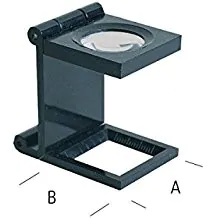Quality Control in the Textile Industry
The advancement of technology in textile production has made material control essential, from the reception of raw materials to the final product output.
Specific Properties
- Control of geometric properties
- Control of mechanical properties
- Control of retentive properties
Geometric Properties
Grammage
Grammage indicates the weight of the fabric in g/m². It is measured by cutting a 10x10 cm circular specimen, weighing it, and multiplying the result by 100, according to UNE 12127 standard.

Fabric Density
Density is determined by counting threads and picks per centimeter with the help of a thread counter, which magnifies the vision and delimits the measurement.

Weaves
The weave corresponds to the interlacing of warp and weft. Its verification is carried out by observation with a thread counter. Standards UNE 40017 and UNE 40161.
Dimensional Stability
It is measured after a washing and drying cycle. UNE standard recommends the Wascator washing machine. The maximum accepted variation is 3%.
Deformation and Distortion
UNE 40.079 standard. It evaluates:
- Warp or weft bowing
- Double bowing
- Skew
Mechanical Properties
Tensile Strength
Measured with a dynamometer. Evaluates the breaking strength and elongation of the fabric.
Crease Resistance
Assesses the fabric’s ability to recover its shape after a load. UNE-EN 22313:1993 standard.
Snagging Resistance
Test according to ASTM 3939 standard, especially in knitted fabrics. The snagging degree is evaluated on a scale from 1 to 5.
Retentive Properties
Color Fastness
- Light: UNE-EN-ISO 105 B02 2001 standard (Xenotest). Scale 1–8.
- Washing: UNE-EN-ISO 105 C06 1997 standard (Linitest).
- Rubbing: UNE-EN-ISO X12 2003 standard (Crockmeter).
- Ironing: UNE-EN ISO 105-X11:1997 standard (Fixotest).
- Water and sweat: UNE-EN-ISO 105 EO1/E04 standard (Perspirometer).
- Dry cleaning: UNE-EN-ISO 105 D01 1996 standard.
Light Box
Color fastness evaluations are carried out in a light box, with samples on a white background under standard illuminant D65.
Other Tests
- Abrasion: UNE-ENISO-12.947 standard (Martindale Abrasion Tester).
- Pilling: UNE-EN-ISO 12945-2 standard (Martindale). Scale 1–5.
- Impermeability: Air (UNE-EN 9237) and Water (UNE-EN 20811).
- Water repellency: UNE-EN 24920 standard (Spray test).
- Breathability: UNE EN 31092 / ISO 11092.
- Thermal insulation: Comfort evaluation under real conditions.
- Water- and oil-repellent finishes: 3M Test II method and AATCC 118:1984.
- Antibacterial: ISO 20743:2007 standard.
- Laminates: Cohesion tests by dynamometry.
- UV rays: UV-Standard 801-1998.
- Fire resistance: Flammability, flame spread, smoke, heat, dripping.
- Aging: Climatic chambers for temperature and humidity cycles.
- Handle (fabric feel): Kawabata Evaluation System (KES).

